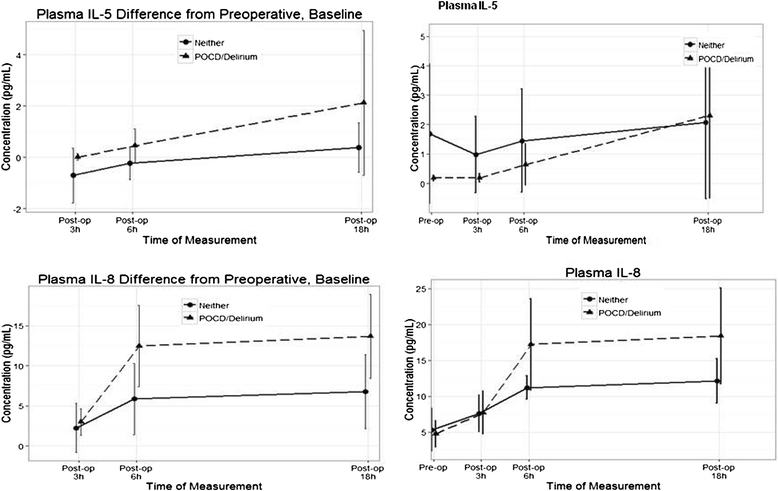Perioperative cerebrospinal fluid and plasma inflammatory markers after orthopedic surgery
- PMID: 27577265
- PMCID: PMC5006595
- DOI: 10.1186/s12974-016-0681-9
Perioperative cerebrospinal fluid and plasma inflammatory markers after orthopedic surgery
Abstract
Background: Postoperative delirium is prevalent in older patients and associated with worse outcomes. Recent data in animal studies demonstrate increases in inflammatory markers in plasma and cerebrospinal fluid (CSF) even after aseptic surgery, suggesting that inflammation of the central nervous system may be part of the pathogenesis of postoperative cognitive changes. We investigated the hypothesis that neuroinflammation was an important cause for postoperative delirium and cognitive dysfunction after major non-cardiac surgery.
Methods: After Institutional Review Board approval and informed consent, we recruited patients undergoing major knee surgery who received spinal anesthesia and femoral nerve block with intravenous sedation. All patients had an indwelling spinal catheter placed at the time of spinal anesthesia that was left in place for up to 24 h. Plasma and CSF samples were collected preoperatively and at 3, 6, and 18 h postoperatively. Cytokine levels were measured using ELISA and Luminex. Postoperative delirium was determined using the confusion assessment method, and cognitive dysfunction was measured using validated cognitive tests (word list, verbal fluency test, digit symbol test).
Results: Ten patients with complete datasets were included. One patient developed postoperative delirium, and six patients developed postoperative cognitive dysfunction. Postoperatively, at different time points, statistically significant changes compared to baseline were present in IL-5, IL-6, I-8, IL-10, monocyte chemotactic protein (MCP)-1, macrophage inflammatory protein (MIP)-1α, IL-6/IL-10, and receptor for advanced glycation end products in plasma and in IFN-γ, IL-6, IL-8, IL-10, MCP-1, MIP-1α, MIP-1β, IL-8/IL-10, and TNF-α in CSF.
Conclusions: Substantial pro- and anti-inflammatory activity in the central neural system after surgery was found. If confirmed by larger studies, persistent changes in cytokine levels may serve as biomarkers for novel clinical trials.
Keywords: Blood-brain barrier; Delirium; Immune response; Surgery.
Figures


References
Publication types
MeSH terms
Substances
Grants and funding
LinkOut - more resources
Full Text Sources
Other Literature Sources
Medical
Miscellaneous

